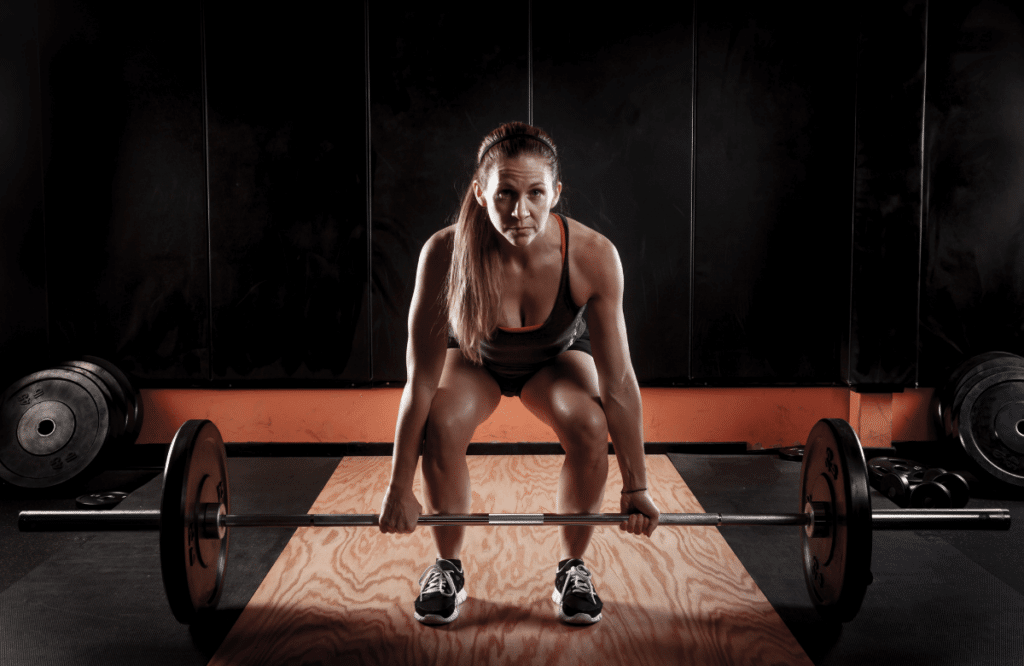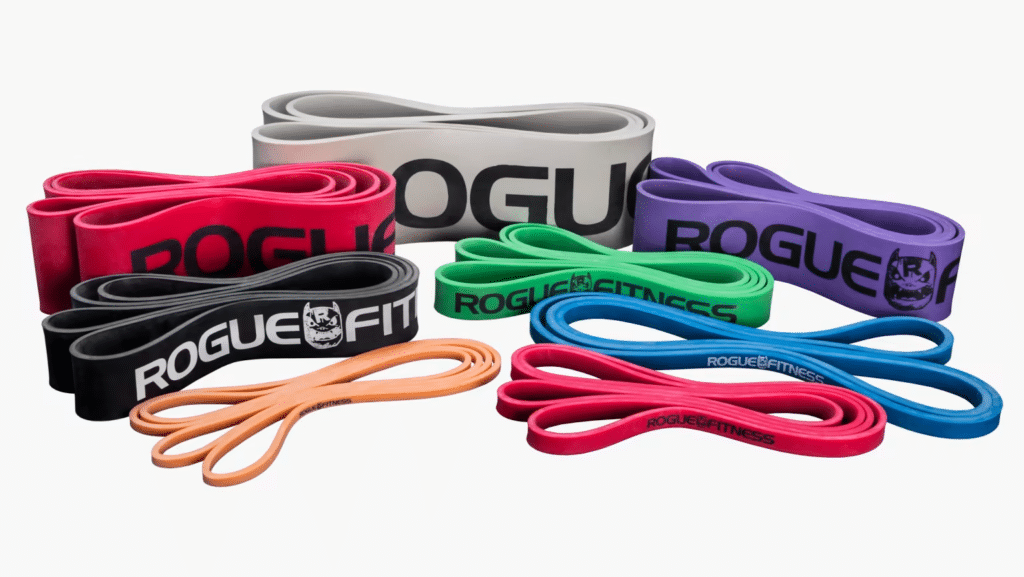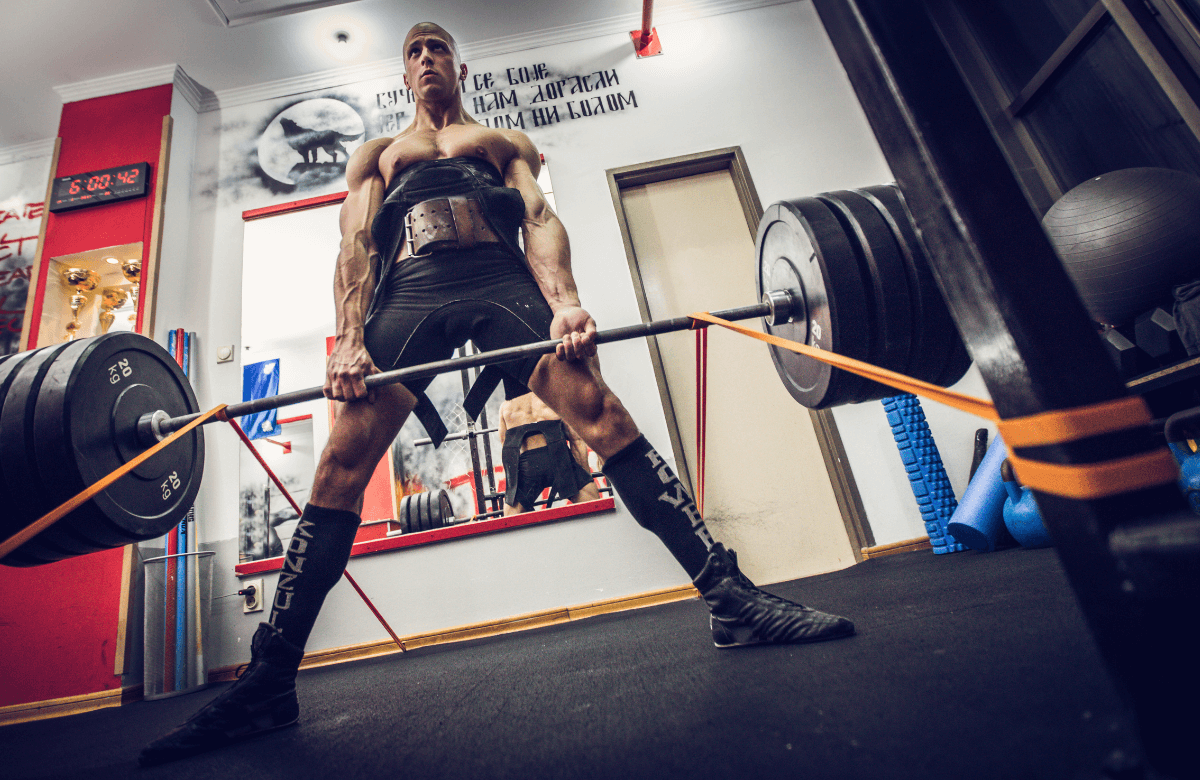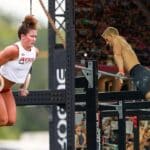Deadlifts are essential to full-body training and lower-body strength. Any deadlift variation is going to have a positive impact on your health.
However, when it comes to deadlifts with resistance bands, they provide added benefits to your training routine that you won’t find elsewhere, such as the following:
– More lat recruitment
– Building strength in the lockout
– Increase bar speed
– Enhanced your technique
– Adds more intensity while keeping the training volume down
In this article, I’ll cover more in-depth these 6 reasons to add banded deadlifts to your workouts, how to wrap the band around the bar, when you shouldn’t train with bands, and which bands you should use.
Let’s dive in!
Jump to:
What Is a Banded Deadlift?
A banded deadlift is a conventional deadlift with bands attached to the barbell, which adds more resistance, making the lift more challenging.
You can wrap the band around the bar or use a specialized deadlift platform with pins to secure the band. Resistance band deadlifts are a terrific way to increase muscle tension without adding more weight to the bar.
The resistance band deadlift variation is commonly seen in intermediate or advanced lifters looking to improve certain aspects of their deadlift technique. It’s not an alternative I’d recommend to a beginner until they’ve gained enough strength and technique.

How To Wrap The Band Around The Bar
There are two main ways to wrap the band around the bar:
- Stepping over the band
- Banded Deadlift platform
To learn how to set up the banded deadlifts, follow this step-by-step guide and make the most of your training session.
Let’s jump in!
Stepping Over The Band
Stepping over the band is one of the easiest and most accessible ways to do deadlifts with resistance bands. However, the bottom of the feet can feel slightly uncomfortable for some people, depending on their shoes.
Despite that, the benefits outweigh the downsides. For this variation, you only need a band to set it up, and here’s how:
- Put the looped resistance band on top and parallel to the center of the barbell.
- Grab the band below the bar and place your feet on top.
- Adjust your stance according to the type of deadlift you’re about to do (conventional, staggered, or sumo).
- Hold the barbell with your preferred grip (overhand, mixed, or with straps).
- Lastly, lift the barbell upwards, keeping a neutral spine until your hips and knees are locked out.
Although some individuals may feel discomfort on their feet because of the band pulling up, it’s usually a matter of time before you get used to it and it increases the intensity of the workout.
Banded Deadlift Platform
A banded deadlift platform has pins on the front and the back to anchor or attach the band from the platform to the bar. This is the most comfortable and effective way of doing banded deadlifts.
However, the average price for a specialized banded platform is around $500, which can be a limiting factor for many people. Another inconvenience could be needing two bands instead of one in the first variation we covered.

Nevertheless, here’s the step-by-step guide to help you start with this banded deadlift variation:
- Step on top of the banded deadlift platform.
- Set up your barbell weight as you would with a standard deadlift.
- Grab one extreme of the resistance band and attach it to one of the platform’s pins.
- Grab the other extreme, and take it over the barbell to the other platform pin.
- Repeat steps 3 and 4 on the other side of the platform.
- Adjust your stance according to the type of deadlift you’re about to do (conventional, staggered, or sumo).
- Hold the barbell with your preferred grip (overhand, mixed, or with straps).
- Lastly, lift the barbell upwards, keeping a neutral spine until your hips and knees are locked out.
This variation is safer and more comfortable, but it does come at a price. However, if you’re serious about your training and can afford a good platform, I suggest you go for it because they are worth it. Regardless, both variations are fantastic and work for various people.
6 Reasons To Add Banded Deadlifts To Your Workouts
Let’s review the following reasons to add banded deadlifts to your workout.
1. Helps You Increase Lat Recruitment
Using a band for deadlifts is a way to help you increase lat recruitment. It creates more tension on your back, forcing you to recruit more muscle to secure a proper bar path and form.
Before lifting the barbell, drive your shoulders down and back. This will emphasize your lats through the entire range of motion and push them to grow.
2. Build Strength In The Lockout
This is a common variation to help people having trouble extending their knees and hips fully.
The resistance band increases the tension as you go up, which technically makes the lockout portion of the lift the most challenging part.
As you get closer to the top, your hips will want to stay hinged, so you take advantage of it and increase the glute recruitment to help you with the lockout.
3. Aids In The Bar Acceleration Through The Range Of Motion
Doing deadlifts with resistance bands is one of the best variations for aiding vertical bar acceleration.
With regular deadlifts, you can’t add more resistance besides the weight it’s already on. Therefore, acceleration diminishes after time your body gets used to it.
Adding a band will create additional external resistance, which translates to more bar speed through the mid and top-end range of motion.
4. Enhances Your Technique
A solid technique is essential to building strength safely with deadlifts. The band allows for more feedback on where the bar is throughout the rep range.
Depending on how heavy the bands are, you can feel the resistance from the starting position to the lockout. Even if you’re using an empty barbell, you’ll feel your back muscles coming together to keep your spine and neck neutral.
Eventually, that strength turns into a better technique.
5. Increases Grip Strength
There are several ways to strengthen your grip. But banded deadlifts are one of the best. The external load coming from the band will put more tension on your wrists and forearms, pushing them to grip the bar harder.

Regular deadlifts also work the grip strength, but it’s nowhere close compared to using a band. You can keep the movement light and controlled; your forearms will blow up after a few reps.
And if you want to take it further, add fat grips to the barbell and take your grip training to the next level.
6. It Adds More Intensity While Keeping The Volume Down.
Doing banded deadlifts helps increase the intensity of the workout without lifting heavier weights for more sets and reps.
Because every rep is more challenging than a regular deadlift, you’ll need fewer reps to have the same muscle stimulus.
This shortens your time at the gym and keeps you strong and athletic without putting your body through high-stress lifting sessions.
When You Shouldn’t Add Banded Deadlifts To Your Workout
Although there are many reasons to include banded deadlifts in your training program, there are always some exceptions. Remember that the primary goal of strength training is to keep you healthier for longer, not the other way around.
Here are some scenarios where I wouldn’t recommend you do banded deadlifts:
Coming Off An Injury
Coming off an injury can be a physically and mentally long process. If you don’t take care of all the training variables, you might be doing more harm than good to yourself.
The band tension can be too much for your mid-low back, glutes, hamstrings, and forearm muscles. For that reason, if you’re injured in one or more of those areas, I’d suggest avoiding resistance band deadlifts.
Stay to the trap bar, sumo, or deadlift from blocks, to reduce your range of motion and keep your torso upright.
If You’re A Beginner
The most vital step in your fitness journey is creating adherence and momentum. This means doing foundational and easy-to-learn movements to increase the chances of sticking to your training routine and getting stronger.
Adding a complex movement like resistance band deadlifts can be detrimental to your progress since your body’s musculature is not yet strong enough to endure a safe spine posture throughout the exercise.
Therefore, we recommend avoiding the banded deadlifts until your technique and volume are good enough to add them to your workout routine.
What Band Should You Use?
There are many types of bands you can use for your deadlifts. However, it all boils down to the variable resistances they can offer. Most go from light, medium, to heavy resistance.
Below are some examples of the amount of resistance (pounds) on each band.
Light Resistance Band
Lighter resistance bands are the best option when it comes to bands for deadlifts. They allow our sweet mix between tension and flexibility that helps you go through the range of motion without taxing the body too much.
Typically you’ll find the resistance for a light band around 10-30 pounds which is ideal for keeping the deadlift an explosive movement and a terrific full-body exercise.
Medium Resistance Band
The medium resistance band is between 40-70 pounds, a crucial aspect of powerlifting training. This resistance level is perfect for strengthening the lockout portion of the deadlift.

Advanced lifters often use these bands to improve speed, especially at the end of the range of motion (top).
Heavy Resistance Band
Heavy resistance bands are typically from 70 to 200 pounds. These aren’t used as frequently as the medium and light resistance.
However, heavy resistance can help you get stronger during the first pull of the deadlift (from floor to knees). Lifting the bar higher than that can be extremely difficult (and unnecessary) at this resistance.
One aspect you should consider is lowering the weight as the band resistance increases. Even if you’re an advanced lifter, you could compromise your technique and spine health if you try too heavily on weights and bands.
Try This Sample Workout With Banded Deadlifts
Now that you’ve learned about banded deadlifts, it’s time to put the theory to practice. Below you’ll find a sample workout that includes a few banded deadlift variations mixed with regular movements.
Before diving in, I’d recommend using a light band (15-30 pounds) and going through a proper warm-up so your muscles are ready for the main lifts.
This workout will focus on building muscle and strength in your lower body, especially your glutes, hamstrings, and spinal erectors.
Without further due, let’s lift!
A1) Conventional Banded Deadlift (8-12 reps)
A2) DB Reverse Lunges (16-20 reps total)
A3) Hollow Rocks (12-20 reps)
3 sets, and rest 2-3 minutes in between.
B1) Romanian Banded Deadlift (8-10 reps)
B2) DB Box Step-Ups (16-20 reps total)
B3) Mountain Climbers (40-60 reps total)
3 sets, and rest 2-3 minutes in between.
C1) DB Banded Deadlift (6-10 reps)
C2) Glute Bridge (12-20 reps)
2 sets, and rest 2-3 minutes in between.
Pick a weight that feels challenging yet manageable. If you feel you can go heavier, feel free to do so, as long as you keep your technique clean and sound.
FAQ
What Are Banded Deadlifts Good For?
Resistance band deadlifts are good for strengthening the lockout portion of the deadlift and the muscles (spinal erectors, glutes, and hamstrings) involved. The band will increase external resistance as you reach upwards for the top of the deadlift, which leads to more muscle recruitment.
Are Banded Deadlifts Easier?
Banded deadlifts are not easier. On the contrary, they’re considerably harder compared to a conventional deadlift. That’s because the band provides additional resistance at the top of the movement, which makes the lockout more challenging.
How Do You Set Up A Banded Deadlift?
To set up a banded deadlift, put the looped resistance band on top and paralleled to the center of the barbell. Grab the band below the bar, place your feet on top, and adjust your stance. Lastly, grip the barbell and lift it upwards, keeping a neutral spine until your hips and knees are locked out.














